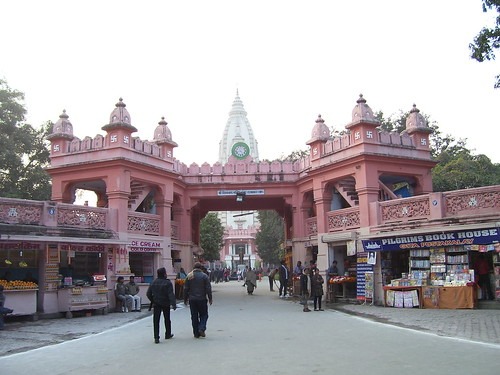
The ghats of Varanasi hold immense spiritual importance for Hindus. It is believed that bathing in the holy Ganges River at Varanasi can cleanse one’s sins and lead to liberation from the cycle of reincarnation. Many devout Hindus visit these ghats to perform various religious rituals, including prayers, cremations, and ceremonies dedicated to their ancestors.
Varanasi, also known as Kashi or Benares, is one of the oldest continuously inhabited cities in the world. It is considered the spiritual capital of India and is home to over 80 ghats along the banks of the Ganges River. Each ghat has its own significance and is associated with different deities and rituals.
The Main Ghats
Among the numerous ghats in Varanasi, there are a few that are considered the main ones and attract the most devotees and tourists:
1. Dashashwamedh Ghat
Dashashwamedh Ghat is one of the most popular and oldest ghats in Varanasi. It is believed that Lord Brahma performed the Dashashwamedh Yajna (a ritual sacrifice) here. Every evening, a grand Ganga Aarti (a prayer ceremony dedicated to the Ganges River) takes place at this ghat, attracting a large crowd. Devotees gather to witness the mesmerizing spectacle of priests offering prayers and lamps to the river.
2. Manikarnika Ghat
Manikarnika Ghat is the most sacred and significant ghat in Varanasi for cremations. It is believed that Lord Shiva himself resides at this ghat. Hindus believe that cremation at Manikarnika Ghat ensures moksha (liberation from the cycle of birth and death). The ghat is always bustling with activity, as funeral pyres burn continuously, and the ashes are immersed in the Ganges.
3. Harishchandra Ghat
Harishchandra Ghat is another important ghat for cremations in Varanasi. It is named after the legendary king Harishchandra, known for his truthfulness and sacrifice. According to Hindu mythology, Harishchandra worked as a cremator at this ghat to repay his debts. Devotees believe that performing the last rites of their loved ones at this ghat brings them eternal peace.
4. Assi Ghat
Assi Ghat is situated at the confluence of the Ganges and Assi rivers. It is believed to be the place where Lord Shiva, after slaying the demon Shumbha-Nishumbha, threw his sword, creating a stream that became the Assi River. This ghat is a popular spot for pilgrims and tourists, who come here to take a holy dip in the river and seek blessings.
5. Panchganga Ghat
Panchganga Ghat is considered a sacred spot where five rivers are believed to meet: the Ganges, Yamuna, Saraswati, Kirana, and Dhutapapa. It is believed that taking a bath at this ghat can wash away all sins. The ghat is also associated with the famous Kashi Vishwanath Temple, dedicated to Lord Shiva.
Spiritual Practices and Rituals
Visiting the ghats of Varanasi offers a unique spiritual experience. Devotees engage in various practices and rituals to seek blessings and spiritual purification:
1. Bathing in the Ganges
One of the most important rituals performed at the ghats is taking a holy dip in the Ganges. It is believed that bathing in the sacred river can wash away sins and purify the soul. Devotees immerse themselves in the water, recite prayers, and offer flowers and diyas (oil lamps) to the river as a form of worship.
2. Ganga Aarti
The Ganga Aarti is a mesmerizing prayer ceremony held every evening at Dashashwamedh Ghat. Priests dressed in traditional attire perform elaborate rituals, waving incense sticks, lamps, and conch shells, while chanting hymns and prayers. The atmosphere is filled with devotion and spirituality as devotees gather to witness this divine spectacle.
3. Cremations
Manikarnika Ghat and Harishchandra Ghat are the primary ghats where cremations take place. Hindus believe that cremation at these ghats ensures the departed soul attains moksha. The continuous burning of funeral pyres is a reminder of the impermanence of life and the cycle of death and rebirth.
4. Boat Rides
Exploring the ghats of Varanasi by boat is a popular activity among tourists. It offers a unique perspective of the city and allows visitors to witness the rituals and ceremonies taking place along the riverbanks. The boat ride provides a serene and peaceful experience, especially during sunrise and sunset.
5. Puja and Offerings
Devotees often perform puja (worship) at the ghats, offering flowers, incense, and food to the deities. They seek blessings for themselves and their loved ones and express gratitude for the divine presence. Many also release diyas (oil lamps) into the river, symbolizing the offering of light and prayers.
The Spiritual Significance
The ghats of Varanasi hold deep spiritual significance for Hindus. They are considered the stairways to the divine, connecting the earthly realm with the spiritual realm. The rituals and practices performed at these ghats are believed to bring spiritual purification, liberation from the cycle of reincarnation, and blessings from the deities.
Varanasi’s ghats are not just places of religious importance but also cultural hubs. They showcase the rich heritage and traditions of India. The ghats are bustling with activity throughout the day, with sadhus (holy men), priests, pilgrims, and tourists coexisting in harmony.
Visiting the ghats of Varanasi is a transformative experience that offers a glimpse into the ancient spiritual traditions of India. It allows one to connect with their inner self, witness the cycle of life and death, and experience the profound spirituality that permeates the city.
Whether you are a devout Hindu seeking spiritual enlightenment or a curious traveler exploring different cultures, the ghats of Varanasi are a must-visit destination. They offer a unique blend of spirituality, history, and cultural immersion that will leave a lasting impression on your soul.
So, immerse yourself in the divine aura of Varanasi’s ghats, and let the sacred waters of the Ganges cleanse your mind, body, and soul.
Enter your email to get the Latest Updated Exploring News and Topics
Discover more from atozexplore.com
Subscribe to get the latest posts sent to your email.






